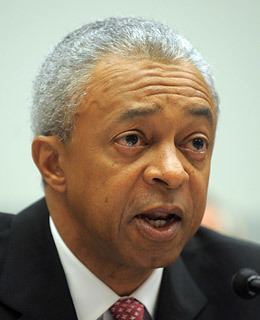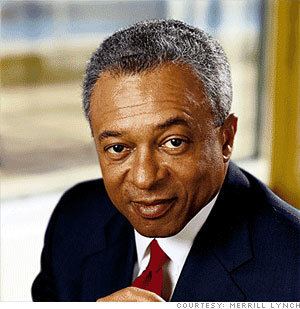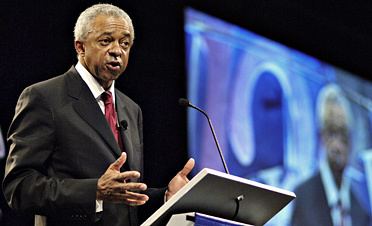Nationality American Children 2 | Citizenship USA Spouse Nancy Garvey (m. 1983) | |
 | ||
Born October 7, 1951 (age 65) ( 1951-10-07 ) Roanoke, AL Employer General MotorsMerrill Lynch Known for 2nd to last CEO of Merrill Lynch; Similar Charles Prince, John Thain, James Cayne, Angelo Mozilo, Richard S Fuld - Jr | ||
How to pronounce earnest stanley o neal american english us pronouncenames com
Earnest Stanley O'Neal (born October 7, 1951) is an American business executive who was formerly Chief Executive Officer and Chairman of the Board of Merrill Lynch & Co. Inc., having served in numerous senior management positions at the company prior to this appointment. O'Neal was criticized for his performance during his tenure as chief executive at Merrill Lynch, where he oversaw the deterioration of the firm's stability and capital position, which resulted in his ouster in September 2007, and the firm's eventual fire sale to Bank of America one year later. Prior to his tenure as Chairman and CEO, Merrill Lynch had thrived as a stand-alone company since 1914.
Contents
- How to pronounce earnest stanley o neal american english us pronouncenames com
- Stanley o neal kathy summers an friends ozark outdoors civil war
- College years
- Career
- Merrill Lynch
- Post resignation
- Financial Crisis Inquiry Commission
- Google search controversy
- References

O'Neal was a member of the board of directors of General Motors from 2001 through 2006. He currently serves on the board of Alcoa.

Stanley o neal kathy summers an friends ozark outdoors civil war
College years

O'Neal's father moved his family from Wedowee, Alabama to Atlanta, where he worked on a General Motors assembly line. Stan O'Neal also worked briefly on GM's assembly line as a teenager under a work-study program offered by the General Motors Institute (later known as Kettering University), where he gained a degree in industrial administration in 1974. GM later provided O'Neal a scholarship to attend Harvard Business School, where he attained his MBA in 1978 and later rejoined GM as a Treasury Analyst.
Career
O'Neal initially worked as an analyst for General Motors; within two years he was a director in the treasury division.
Merrill Lynch
In 1986, he joined Merrill Lynch and by the early 1990s, he was running Merrill's leveraged finance division. After spells as global head of capital markets and co-head of the corporate and institutional client group, he spent two years as CFO from 1998 to 2000. In 2000, he was appointed president of the U.S. Private Client Group, the first executive of the division that oversees Merrill's brokerage who had not himself been a broker. O'Neal led massive layoffs within the division.
O'Neal became president of the firm in 2001 in a palace intrigue that eventually led to the early ouster of his predecessor and one-time mentor David Komansky. By 2003, he was CEO and chairman. He was one of the first African Americans to hold such a high position on Wall Street. O'Neal earned $48 million in 2006 and $46 million in 2007. One of his first moves as CEO was to dismiss his number two executive, executive vice chairman Thomas H. Patrick, Sr., and afterward Arshad R. Zakaria who headed institutional banking and securities. Originally there had been a deal where Patrick and Arshad R. Zakaria would support O'Neal's promotion to CEO, and in return Zakaria would be appointed president, however once O'Neal became CEO he refused to continue this "backroom dealing".
As CEO, he attempted to get rid of the 'Mother Merrill' culture of job security, arguing that it promoted cronyism instead of merit. He also wanted to transform Merrill into a trading powerhouse, and beat Goldman Sachs at its own game. After the departure of Chris Ricciardi, O'Neal hired Osman Semerci on the advice of fixed-income head Dow Kim and chief administrative officer Ahmass Fakahany. Semerci continued the push into the subprime mortgage-backed CDO market and grew the firm's position from $5 to $6 billion worth of exposure to $55 billion in under one year, while firing respected trader Jeff Kronthal and demoting risk manager John Breit both of whom had warned against too much exposure to CDOs. Merrill was one of the top CDO underwriters of the boom era, a plan that initially brought huge bonuses to Merrill until the markets turned. According to the then-president of Merrill, Greg Fleming, the dismissal of Kronthal in July 2006 was the day Merrill Lynch’s fate was sealed, otherwise the firm may have "avoided the subprime problems that would soon bring Wall Street to its knees. After that date, Merrill was doomed to make the same mistakes as its competitors."
O'Neal was regarded as out of touch as the market changed and Merrill steered towards trouble, as he had "become isolated from his own firm. He had no idea that key risk managers had been pushed aside or that the people he had put in important positions were out of their depth". O'Neal was described as a manager who "had never been the kind of C.E.O. who walked the trading floor. By 2006, he was so divorced from his own firm that he failed to appreciate the utter lunacy of Semerci’s desire to clean house. Did he really think Semerci could get rid of Merrill’s most experienced mortgage traders and not harm the mortgage desk? Sadly, it seems that O’Neal didn’t think about it at all." "At the same time Goldman executives were canceling vacations to deal with the burgeoning subprime crisis, O’Neal was often on the golf course, playing round after round by himself", in fact six months before Bear Stearns nearly collapsed Merril added tens of billions of risky securities to its balance sheet while Goldman moved to reduce exposure.
During August and September 2007, as the sub-prime crisis swept through the global financial market, Merrill Lynch announced losses of $8 billion. O'Neal finally realized the huge exposure that Merrill had to subprime mortgage-backed CDOs, and that the firm would have to be sold in order to survive. As the crisis worsened, O'Neal approached Bank of America and Wachovia Bank about a possible merger, without first obtaining the approval of Merrill's Board of Directors, which led to his ouster. On October 30, 2007 O'Neal resigned as CEO. He left with a severance package including Merrill stock and options worth $161.5 million on top of the $91.4 million in total compensation he earned in 2006.
Post-resignation
The board hired John Thain from NYSE Euronext to replace O'Neal as chairman and CEO, believing that Thain could save the business, however the markets and the firm continued to deteriorate in 2008. Thain was forced to merge Merrill with Bank of America in September 2008, the weekend after Lehman Brothers filed for bankruptcy.
On January 18, 2008, O'Neal was named to the board of directors of Alcoa.
O'Neal is said to have an "abrasive" personality. When Thain arrived at Merrill he scrapped O'Neal's practice of having the security guards always hold an entire elevator bank open exclusively for him.
CNBC includes O'Neal in their list of "Worst American CEOs of All Time". The New York Times Magazine on April 18, 2010 described O'Neal as one of the "feckless dolts" who helped precipitate the financial crisis of 2007. During the final hearings prior to the firm's merger with Bank of America, numerous people – including a founder's son, Win Smith – laid the blame on O'Neal for the firm's downfall and loss of independence.
Financial Crisis Inquiry Commission
On March 11th of 2016, a release of documents by the National Archives revealed that the Financial Crisis Inquiry Commission had recommended that O'Neal be prosecuted for multiple crimes in connection with his activities as CEO of Merrill Lynch during the lead up to the sub-prime crisis.
Google search controversy
In July 2014, business journalist Robert Peston said that the BBC had received a notification that an article that he had written on the BBC website in 2007 would no longer be findable when searching on Google Search in Europe. Peston initially suggested that it was his negative comments about O'Neal that had led to the request under the terms of the court ruling Google Spain v AEPD and Mario Costeja González. Peston later said that he was unsure why the notification had been received, and speculated that it may have been due to one of the comments posted on the article. O'Neal denied knowledge of the takedown notification.
